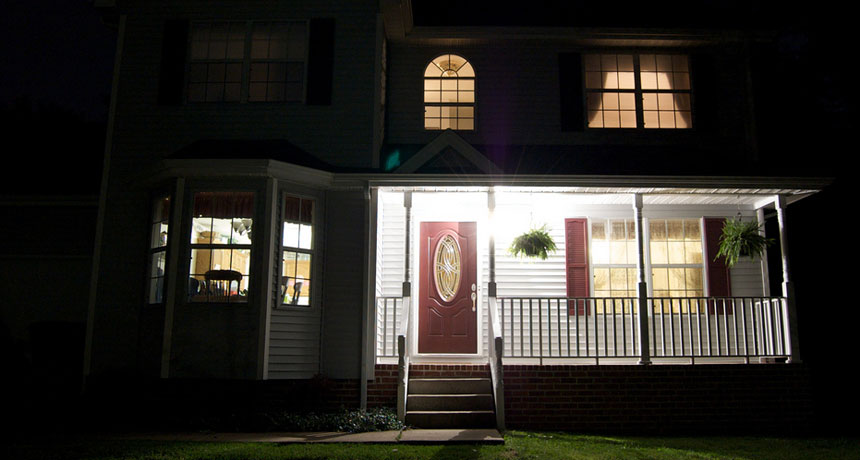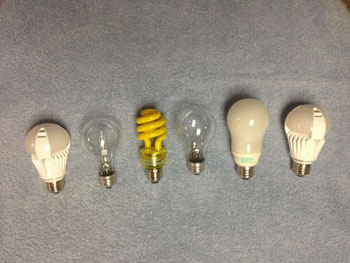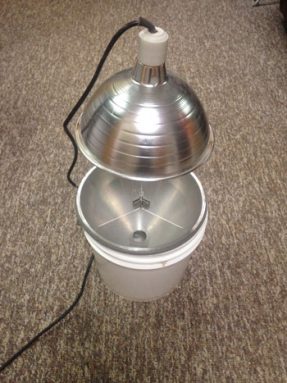Picking a better porch light
Some types of lights attract far fewer insects than others, including pests

The type and color of bulb used in a porch light can greatly affect the number and type of bugs it attracts.
Casey Fleser/Flickr (CC-BY 2.0)
By Sid Perkins
WASHINGTON, D.C.— Lights tend to lure large numbers of outdoor insects at night. There’s even an old saying that describes this irresistible attraction: like a moth to a flame. But when it comes to attracting bugs, not all lights are equal. Which ones are most alluring can be traced to the wavelengths — colors of light — that they give off. A new study has just quantified how different types of white lights, which vary greatly in the wavelengths they emit, compare in attracting bugs.
People designing bug-zappers will want lights that are the most attractive to insects. But homeowners looking for a porch light or who want to protect their plants will want just the opposite, says Michael Justice. He’s a scientist in Lynchburg, Va., who took part in the testing. As a behavioral ecologist, he studies such things as how animals react to their environment or to changes in it.
Justice and his colleagues put together a simple experiment. They hung pieces of clear plastic under a light bulb and suspended both over a bucket of liquid topped by a funnel. Insects that flew beneath the light would hit the plastic and then fall through the funnel into the bucket. The liquid preserved the bugs until the team could identify the species and count them.

The researchers tested five types of white or whitish light bulbs. One was the old-fashioned incandescent that is being largely phased out in industrial nations. These bulbs heat up a small wire until it glows, emitting a broad range of wavelengths. The second type was a compact fluorescent bulb. It contains a gas that emits light in only a narrow range of wavelengths. The halogen light that they tested takes its name from the type of gases and other materials inside it. These bulbs produce a pattern of wavelengths similar to the incandescent bulb.
The team also tested two types of bulbs whose glow comes from light-emitting diodes, or LEDs. One of these bulbs emitted light more strongly near the blue end of the visible spectrum than the other.
The team then compared these lights to the so-called “bug light.” This yellow bulb’s golden light is supposedly harder for some insects to see than bluer or whiter hues. These bulbs also advertise that they won’t draw bugs to your house.
The team conducted its testing during the summer. They used only one type of bulb each night, but over the course of the summer they tested each type of bulb many times. At sundown, they put out the test apparatus and turned on its light. At dawn the next day they collected any insects that had been drawn to the light and trapped.
On nights between April 26 and September 28, their bucket collexcted more than 8,600 insects and 259 spiders. It’s not clear if the spiders were attracted to the lights or if they were attracted to the insects as a food source, the researchers say. They presented their findings here, February 14, at the annual meeting of the American Association for the Advancement of Science.
The total number of hours each bulb was tested varied slightly, due to weather and other factors. So the team calculated how many insects of each type were attracted during each hour of test time. Overall, the white incandescent light brought in the largest number of insects, about 8.2 per hour. The white LED light bulb that emitted more strongly at the reddish end of the visible spectrum attracted the fewest insects, about 4.5 per hour. Indeed, it lured even fewer insects than the yellow bug light.

And even the bug light didn’t perform well against certain insects. For instance, that bug light attracted more insects from the order Dermaptera (Der-MAP-tur-ah) — earwigs and their close kin — than did any of the white-light bulbs. True bugs, which include stinkbugs and their close cousins, belong to a group called Hemiptera (Heh-MIP-tur-ah). These were most attracted to the white incandescent bulb. It lured in about three bugs every four hours. The yellow bug light attracted about the same number of those bugs each hour. So if you have stink-bug problems, don’t expect a yellow bug light to keep them away.
The bulb that attracted the fewest Hemiptera was the white LED that shone at the reddish end of the visible spectrum. It lured less than half as many of the true bugs, only about 3 every hour.
A porch light that lures insects by night can leave bugs camping out in local greenery by day, notes Justice. If those bugs are pest species, then the wrong light can be inviting garden bullies to dine on prized plants.
But knowing which lights are most attractive also could help engineers design a better “bug zapper,” he adds. Those devices, which often sport glowing purple bulbs and an electrified metal mesh, are sold as a way to kill flies and mosquitoes. But a previous study showed that more than 97 percent of the insects killed by bug zappers don’t belong to those groups, Justice points out. In fact, he notes, many bugs lured to zappers might be species that would have helped gardeners by eating pests.







